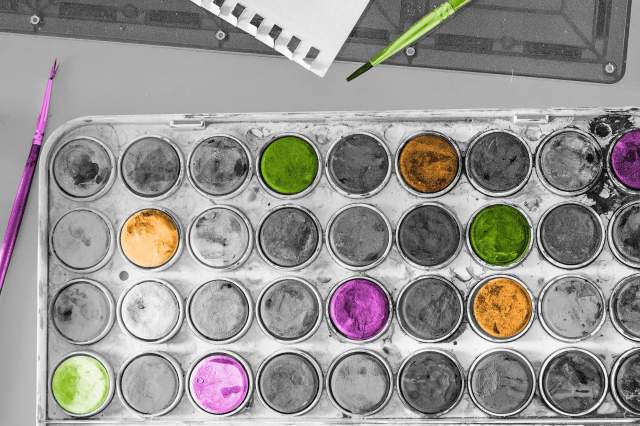
Edvard Munch Hid a Message in “The Scream”
Norwegian artist Edvard Munch’s mental health was tied closely to his work, and one of his most famous paintings, “The Scream,” has an inscription to that effect. It reads “Kan kun være malet af en gal Mand!” — a Norwegian phrase that translates to “Can only have been painted by a madman!” The writing, in pencil at the top left of the painting, is tiny but visible to the naked eye if you look very closely, and infrared technology has recently been able to make it stand out a little bit more.
The inscription was noticed in 1904, 11 years after it was painted, at an exhibition in Copenhagen. At the time, critics thought that a vandal had left the message. But by looking at the writing more closely with infrared light, researchers were able to match the handwriting to the script in Munch’s diaries, which means Munch likely added it as part of the piece.

Pablo Picasso’s Famous Guitarist Has a Woman Behind Him
It’s not uncommon for painters to reuse their canvases; Monet did so frequently, as did other great artists. For decades, viewers reported seeing a ghostly woman behind the figure in Pablo Picasso’s “The Old Guitarist,” before researchers in 1998 used X-ray photography and infrared light to uncover what lies beneath. The full work shows a nude woman seated with her right arm in her lap and her left one extended. The image matches a sketch Picasso sent in a letter to a friend.

Georges Seurat Painted Over a Slightly Creepy Self-Portrait
“Young Woman Powdering Herself,” painted around 1890, shows artist Georges Seurat’s mistress Madeleine Knobloch seated at a vanity. In the top left corner, there’s an open window with a vase of flowers — but originally it was the artist’s face peeking through that window. A friend warned Seurat that it looked a little weird, so he replaced it with the still life. It would have been the only self-portrait of Seurat to exist if he’d kept it.
More Interesting Reads

An Entire Whale Was Missing From a Dutch Masterpiece
“View of Scheveningen Sands,” painted by Dutch artist Hendrick van Anthonissen around 1641, used to have an air of mystery. This seaside landscape painting shows multiple people standing on a beach looking at a spot where nothing much seems to appear — at least until recently. A 2014 restoration at Cambridge University’s Fitzwilliam Museum revealed what all the fuss was about: an entire beached whale, crudely painted over long after Anthonissen finished it. The restorers speculated that the whale was removed sometime in the 18th or 19th century, when obscuring a dead animal could make the work more valuable. Thanks to the restoration, the whale is now clearly visible.

The Sistine Chapel Ceiling May Have Brains on It
The Sistine Chapel features a series of 16th-century paintings by the artist Michelangelo depicting scenes from the book of Genesis. The most famous scene is “The Creation of Adam,” which shows a nude man touching fingers with an interpretation of God as an older bearded man surrounded by angels.
Michelangelo was an expert on human anatomy, inside and out — he started dissecting corpses in his late teens — but there are some irregularities in his figures on the chapel ceiling. Some medical professionals have found what they interpret as images of the human brain in a few different panels. In “The Creation of Adam,” God emerges from a red blob that looks a lot like a cross-section of a human brain. This theory was made famous by the TV show Westworld in 2016, but academic work on the similarity dates back to at least 1990. (Some academics think the red blob could actually be a uterus.)
More subtle brainlike images appear in other Michelangelo panels, too. Some bulbous irregularities in God’s neck in “The Separation of Light and Darkness” resemble the brain as seen from below, and a line running up the center of the figure’s chest almost perfectly resembles a human spinal cord and brain stem.

“The Last Supper” May Have Music Hidden Inside
Between 2003 and 2007, Italian musician Giovanni Maria Pala uncovered what he claims is a piece of music in Leonardo Da Vinci’s 15th-century masterpiece “The Last Supper.” According to him, spiritually potent elements in the painting, such as loaves of bread and the hands of Jesus and the Apostles, represent musical notes that appear once you draw five lines of musical staff down the length of the table. The piece he uncovered didn’t fully make sense to him until he read it from right to left — Leonardo da Vinci nearly always wrote backward. The 40-second passage he gleaned from the painting sounds like a requiem, which he says is best played on a pipe organ.












